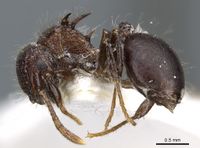Meranoplus armatus
| Meranoplus armatus | |
|---|---|

| |
| Scientific classification | |
| Kingdom: | Animalia |
| Phylum: | Arthropoda |
| Class: | Insecta |
| Order: | Hymenoptera |
| Family: | Formicidae |
| Subfamily: | Myrmicinae |
| Tribe: | Crematogastrini |
| Genus: | Meranoplus |
| Species: | M. armatus |
| Binomial name | |
| Meranoplus armatus Smith, F., 1862 | |
| Synonyms | |
| |
Identification
Distribution
Taylor (2006) - Widespread in Western Melanesia and the Moluccas. Probably indigenous to northern Australia. ===Latitudinal Distribution Pattern=== Latitudinal Range: -5.26569° to -12.7°.
| North Temperate |
North Subtropical |
Tropical | South Subtropical |
South Temperate |
- Source: AntMaps
Distribution based on Regional Taxon Lists
Indo-Australian Region: Indonesia (type locality), New Guinea.
Distribution based on AntMaps
Distribution based on AntWeb specimens
Check data from AntWeb
Countries Occupied
| Number of countries occupied by this species based on AntWiki Regional Taxon Lists. In general, fewer countries occupied indicates a narrower range, while more countries indicates a more widespread species. |

|
Estimated Abundance
| Relative abundance based on number of AntMaps records per species (this species within the purple bar). Fewer records (to the left) indicates a less abundant/encountered species while more records (to the right) indicates more abundant/encountered species. |

|
Biology
Castes=
Worker
Images from AntWeb
   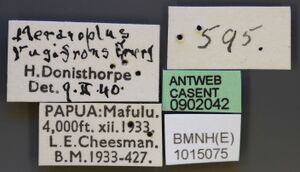
| |
| Worker. Specimen code casent0902042. Photographer Ryan Perry, uploaded by California Academy of Sciences. | Owned by NHMUK, London, UK. |
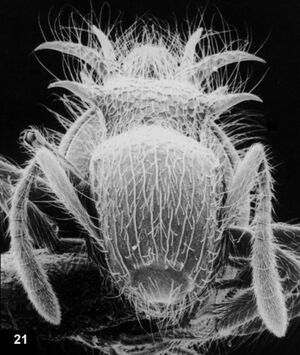  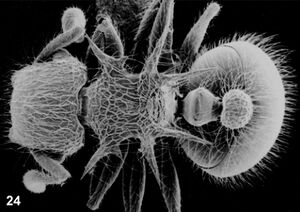 
| |
| . | |
Queen
Images from AntWeb
  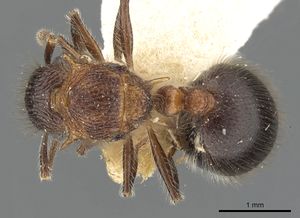 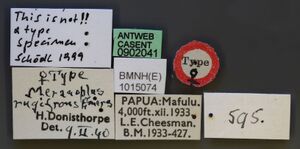
| |
| Queen (alate/dealate). Specimen code casent0902041. Photographer Ryan Perry, uploaded by California Academy of Sciences. | Owned by NHMUK, London, UK. |
Nomenclature
The following information is derived from Barry Bolton's Online Catalogue of the Ants of the World.
- armatus. Meranoplus armatus Smith, F. 1862d: 413, pl. 12, fig. 7 (w.) INDONESIA (Sulawesi or Sumatra).
- Type-material: holotype worker.
- Type-locality: Indonesia: locality equivocal, Sumatra or Sulawesi (no collector’s name).
- [Note: Smith states “Hab. Sumatra”. However, his material was collected,“by a friend who took a few insects at Celebes (= Sulawesi) and also at Sumatra; all the ants he believed were from the latter locality”. Discussed in Taylor, 1990c: 35; Taylor, 2006: 28, says, “Sulawesi seems the more likely”.]
- Type-depository: not in BMNH or OXUM, presumed lost..
- Status as species: Mayr, 1886c: 362; Dalla Torre, 1893: 136; Emery, 1924d: 228; Chapman & Capco, 1951: 112; Taylor, 1990c: 35; Bolton, 1995b: 250; Taylor, 2006: 28.
- Senior synonym of rugifrons: Taylor, 1990c: 35; Bolton, 1995b: 250; Taylor, 2006: 28.
- Distribution: Australia, Indonesia (Sulawesi or Sumatra), Papua New Guinea.
- rugifrons. Meranoplus spinosus subsp. rugifrons Emery, 1897d: 569, pl. 1, figs. 13-15 (w.) NEW GUINEA (Papua New Guinea).
- Type-material: holotype (?) worker.
- [Note: no indication of number of specimens is given.]
- Type-locality: Papua New Guinea: Paumomu River, Moroka, Ighibirei (L. Loria).
- Type-depository: MSNG.
- Viehmeyer, 1914c: 525 (q.).
- Subspecies of spinosus: Viehmeyer, 1914c: 525; Emery, 1924d: 228.
- Status as species: Donisthorpe, 1941c: 136; Chapman & Capco, 1951: 113.
- Junior synonym of armatus: Taylor, 1990c: 35; Bolton, 1995b: 251; Taylor, 2006: 28.
Unless otherwise noted the text for the remainder of this section is reported from the publication that includes the original description.
Description
Type Material
Taylor (2006) - Worker. Either Sumatra or Celebes (=Sulawesi), Indonesia. Sulawesi seem the more likely of the alternative original localities.
References
- Smith, F. 1862d. A list of the genera and species belonging to the family Cryptoceridae, with descriptions of new species; also a list of the species of the genus Echinopla. Trans. Entomol. Soc. Lond. (3) 1: 407-416 (page 413, pl. 12, fig. 7 worker described)
- Taylor, R. W. 1990d. The nomenclature and distribution of some Australian and New Caledonian ants of the genus Meranoplus Fr. Smith (Hymenoptera: Formicidae: Myrmicinae). Gen. Appl. Entomol. 22: 31-40 (page 35, Senior synonym of rugifrons)
- Taylor, R.W. 2006. Ants of the genus Meranoplus F. Smith, 1853: Three new species and others from northeastern Australian rainforests. Myrmecologische Nachrichten. 8:21-29.
References based on Global Ant Biodiversity Informatics
- CSIRO Collection
- Chapman, J. W., and Capco, S. R. 1951. Check list of the ants (Hymenoptera: Formicidae) of Asia. Monogr. Inst. Sci. Technol. Manila 1: 1-327
- Donisthorpe H. 1941. Descriptions of new species of ants from New Guinea. Annals and Magazine of Natural History (11)7: 129-144.
- Janda M., G. D. Alpert, M. L. Borowiec, E. P. Economo, P. Klimes, E. Sarnat, and S. O. Shattuck. 2011. Cheklist of ants described and recorded from New Guinea and associated islands. Available on http://www.newguineants.org/. Accessed on 24th Feb. 2011.
- Lucky A., L. E. Alonso, E. Sarnat, and J. Hulr. 2015. Ants and scolytine beetles. In: Richards, S.J. and N. Whitmore (editors) 2015. A rapid biodiversity assessment of Papua New Guinea's Hindenburg Wall region. Wildlife Conservation Society Papua New Guinea Program. Goroka, PNG.
- Snelling R. R. 1998. Insect Part 1: The social Hymenoptera. In Mack A. L. (Ed.) A Biological Assessment of the Lakekamu Basin, Papua New Guinea, RAP 9. 189 ppages
- Taylor R. W. 1990. The nomenclature and distribution of some Australian and New Caledonian ants of the genus Meranoplus Fr. Smith (Hymenoptera: Formicidae: Myrmicinae). General and Applied Entomology 22: 31-40.
- Taylor R. W. 2006. Ants of the genus Meranoplus F. Smith, 1853 (Hymenoptera: Formicidae): three new species and others from northeastern Australian rainforests. Myrmecologische Nachrichten 8: 21-29.
- Viehmeyer H. 1912. Ameisen aus Deutsch Neuguinea gesammelt von Dr. O. Schlaginhaufen. Nebst einem Verzeichnisse der papuanischen Arten. Abhandlungen und Berichte des Königlichen Zoologischen und Anthropologische-Ethnographischen Museums zu Dresden 14: 1-26.
- Viehmeyer H. 1914. Papuanische Ameisen. Deutsche Entomologische Zeitschrift 1914: 515-535.
